Trying out Amigo in California. His training was California Charro and Pleasure riding.
Has anyone ever told you that your horse has hooves that can’t be barefoot?
I was contacted earlier last year to help out a very experienced horse person, Jennifer D, who had a lovely new Andalusian, Amigo, with some serious soundness issues. Her hope was to use him for Classical Dressage and Pleasure Riding. He certainly had the conformation and the breeding for the discipline, except he wasn’t sound. He looked like he could star in a movie as a Spanish Baroque Warhorse but I wonder if anyone would notice that he wasn’t sound? Jennifer was deeply concerned for her new friend.
Jennifer D purchased the horse after flying from San Antonio, TX to California in late 2010 to see him based on sales pictures that took her breath away. He wasn’t in great physical shape (unless round is considered a shape), nor was he totally sound, but her gut instinct was to bring him back to Texas and to help him. He is gorgeous and he has a wonderful mind. She couldn’t wait to work with him. When she got him back to Texas she began working with him to develop relaxation, his previous riding had been rather opposite of the supportive classical foundation she was providing Amigo.
Amigo seemed sore in his rear end, he would twist in his hocks rather than moving solidly. He had very unbalanced shoulders with one much larger and higher than the other, this made saddle fit very challenging. Amigo was in steel shoes and was being maintained by very well respected farriers, but he had a lingering high/low issue in the front hooves.

Jennifer D working on relaxing Amigo at the canter in Texas.
To Jennifer D’s credit she was very open and persistent about getting to the root of Amigo’s his physical problems. During this period she worked with vets to monitor his hooves with x-rays, and documented his hooves by photographing them after each farrier visit. She kept meticulous records. She worked with bodywork and saddle fit professionals to try to get him as comfortable as possible physically while remaining in work.
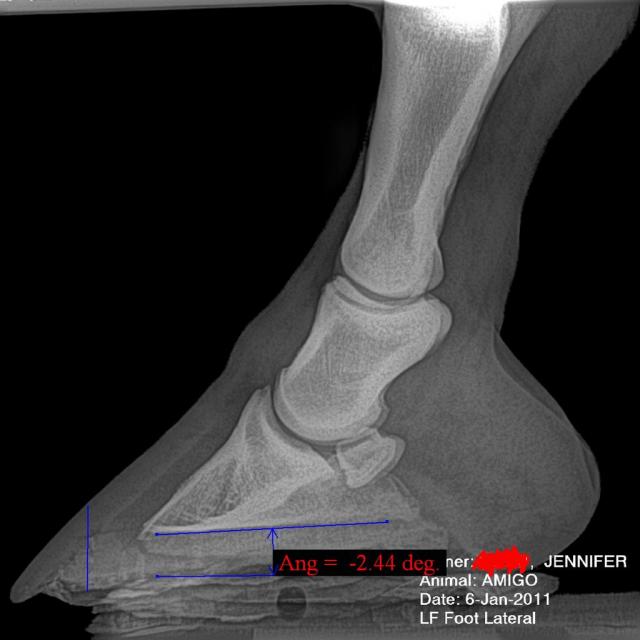
This was Amigo’s “flat” under-run hoof shortly after Jennifer bought him.

This was Amigo’s upright hoof – quite a difference in these two hooves, but both toes are quite stretched.
When she contacted me, she said that her gut instinct was that he would be better off like their other Andalusian, Paz who is sound barefoot. The response she received was that Amigo couldn’t go barefoot. The first time I saw them, we met for a consult at the local soundness wiz-vet for a full workup. The Vet confirmed the twisting in the hocks as being possible arthritis. He also blocked the LF (low) leg and confirmed that he had joint pain in his fetlocked. He performed Shock Wave Therapy on the affected fetlock. Amigo was prescribed with injectable or oral joint supplements. The X-rays that were taken of Amigo that day were a good guide in developing a plan to take Amigo barefoot. We made no hasty changes, I simply offered some suggestions. Meanwhile, the treatments didn’t seem to help much.
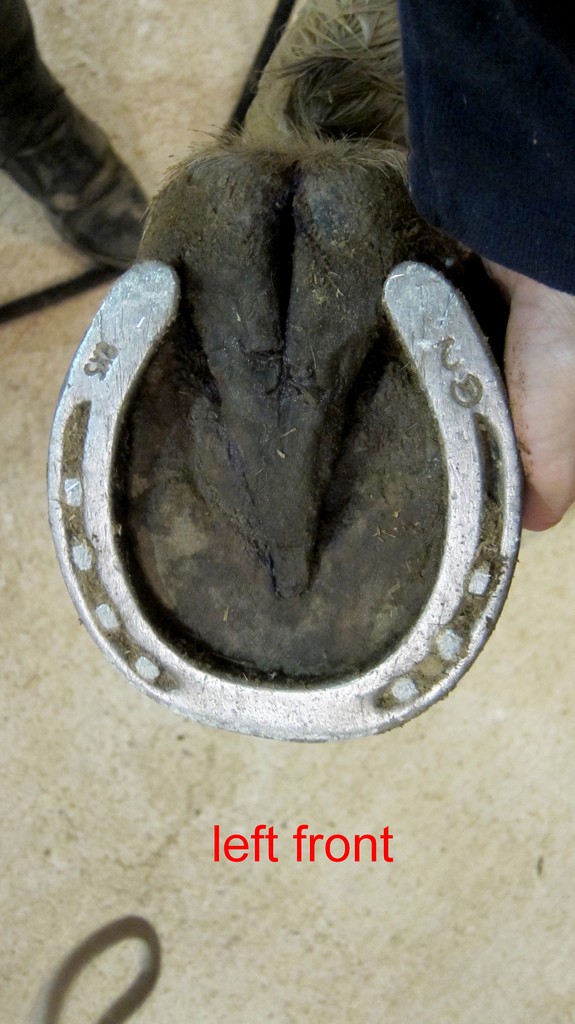
Here is the LF low hoof – How do you pull these shoes and remain in work? Look at the unhealthy central sulcus butt crack in the frog. This is never a healthy situation. Jennifer treated the suspected central infection effectively with cattle mastitis medication. Amigo was sore if you inserted a hoof pick into that crack.
I suggested that one of Amigo’s biggest problems were his hoof form. He had always been in steel shoes, probably without a break. Horses like this often have very little digital cushion development. He had very flared hoof walls and his toes were very long and his heels under-run. He had deep cracks in the central sulcus of his frogs that made me suspect there was an infection in his frogs, despite frequent use of that purple thrush treatment. The vet prescribed a wedge pad in the front hoof to try to match the higher hoof. I suggested that she begin treating Amigo’s frogs for infection using an off-label product that treats mastitis in cattle. I suggested that she should request that her current farrier should back up the toes, while preserving the height of the toes from the bottom. I also suggested that we could try removing the back shoes first, and try to get him comfortable in that situation before removing the front shoes.
We discussed his feeding program. Andalusian horses are typically “easy keepers” and can not tolerate high starch diets. Amigo had been maintained on a diet that was too rich for his metabolism in his prior home. Jennifer D changed his diet to a very low starch ration balancer that would compensate for what was lacking in coastal Bermuda hay. Our typical hay needs to be balanced with more Copper, Zinc, Biotin, Amino Acids, etc to encourage healthy hoof growth.
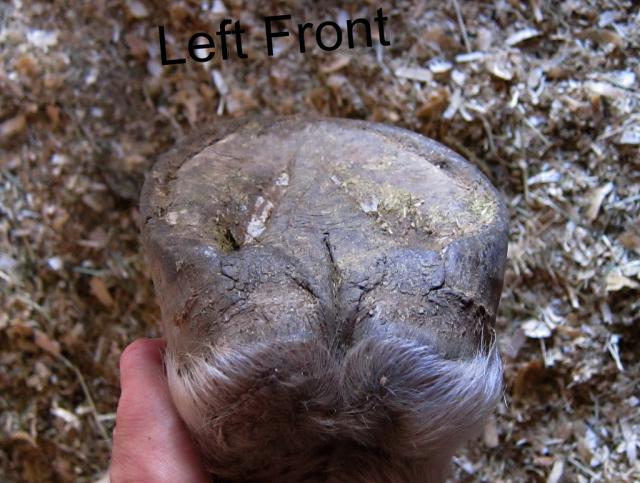
7 months later, this frog is still a bit stretched forward in the “flat” LF hoof, but it is so much healthier! The good, balanced, low starch nutrition and movement has helped as well.
This would be a process over time rather than a quick fix. The ultimate goal was to grow in new, healthier hooves that were better lamina attachment. We wanted to keep him sound for work and help him develop a stronger digital cushion so he could comfortably land heel first and flat in a correct manner. Easyboot Gloves would be prescribed to help him to stay comfortable as needed during this process.
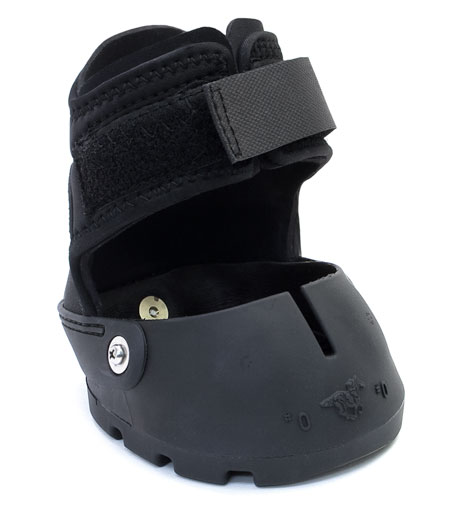
Easyboot Gloves are a suitable hoof boot for dressage training.
When the rear shoes were removed, we noticed that Amigo was growing the medial (inside) of his right rear hoof much longer than lateral (outside) of his hoof wall. This was the hock that was twisting upon landing when he moved. The farrier suggested using Superfast to build an extension of the shorter wall. That was not a lasting solution, so I took over care of the rear hooves and the farrier maintained the fronts. For a time, we met frequently to tweak the back hooves as needed. I put a steeper bevel on the lateral (outer) hoof wall so it wore a bit faster and started to keep up with the wear on the inner wall. With keeping the hoof balanced, Amigo started to become much more comfortable in his movement and the twisting hock began to resolve. We were very encouraged. I do think the joint supplements and bodywork were helpful in this regard as well.
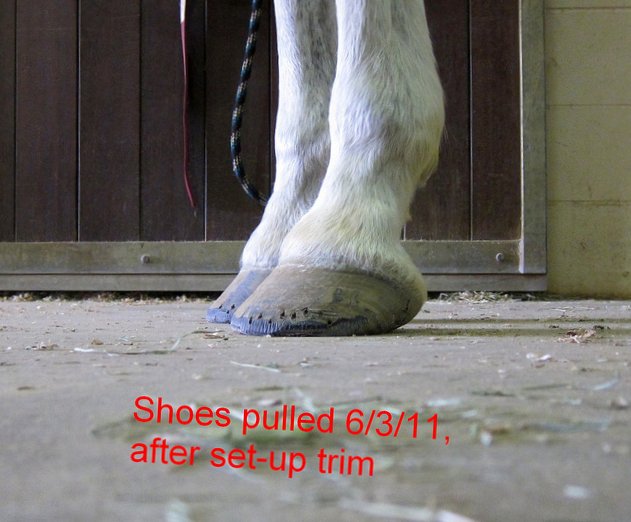
6/11 – Amigo’s front shoes were pulled after 2 cycles in a corrective frog/heel support pad shoeing package. His back hooves had the steel shoes pulled a month prior and naturally trimmed in preparation for going fully barefoot. Transitioning in steps is a great conservative way to approach going barefoot.
Eventually, it was time to remove the front shoes. I gave Amigo a conservative set-up trim, focusing on bringing the toes back so the rest of the hoof could grow in more correctly attached, rather than forward. We fit him in Easycare Glove hoof boots and I encouraged Jennifer to use them anytime that she was going to ride outside of the well groomed indoor arena. His soles were very flat. I also suggested that she consider riding him in the indoor for a time with boots to offer him additional comfort and support so he would use the back of his hoof correctly.
We tested the boots at all gaits with Amigo at liberty in the lovely indoor arena. He put on a show that proclaimed he felt great with gorgeous Spanish movement, playing in the indoor. We asked him to make frequent gait changes, rollbacks at the canter, etc to test the boots and to accustom Amigo to wearing them before asking him to use them under saddle. I suggest everyone test new boots this way before saddling up.
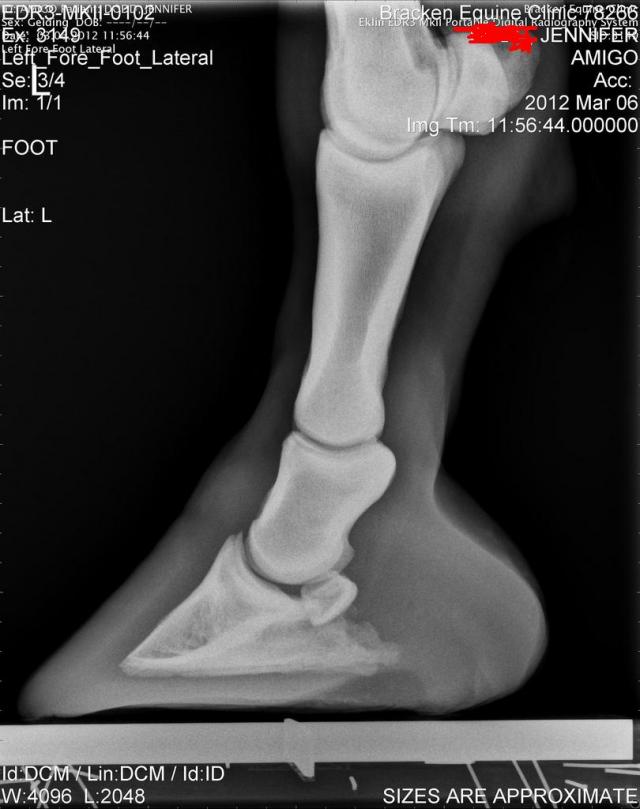
This is the LF about 7 months after we pulled his shoes. We took the X-ray when he was due to be trimmed in case the vet needed us to tweak things. This is his flat hoof and he has grown in a much better attached hoof wall. Because he is due for a trim, his toes need to be backed up. I would like to see him grow a bit more heel, but it is still much improved. He trots sound across gravel for the vet for his check up lameness exam. No more hock twisting unsoundness issues were noted in the rear end at this checkup!
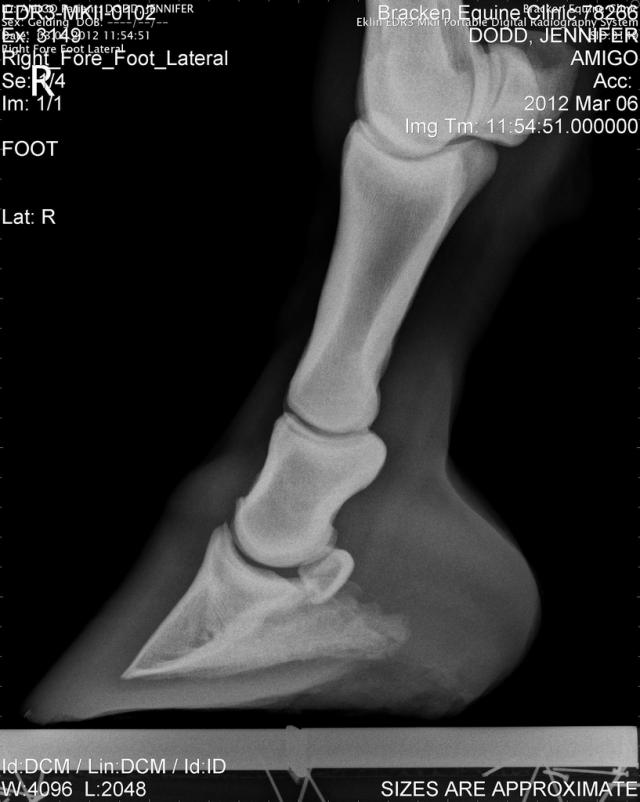
This is the LF about 7 months after beginning this barefoot journey, again he is due for a trim so his toes need to be backed up/break over trimmed. This is a much healthier hoof than the first X-ray.
Over the past few months, we have continued with monthly hoof trimming and Amigo is no longer a lame horse. His saddle fit is no longer an issue because his shoulders match better. His high/low syndrome is no longer problematic as each hoof has grown in toward it’s potential, although they will never be a perfect match. Amigo is progressing beautifully in his classical dressage work and he is a pleasure for Jennifer D to own.
I am very fortunate to have had the opportunity to work with them and I give credit to Glove boots for being a tool to help Amigo’s successful transition from steel shoes. Jennifer D was tireless in finding the solutions to help her horse.
This horse can go barefoot!

How have Easycare boots helped your horse through a tough transition? Do you have any other tips to consider for those that are thinking of trying to go barefoot with their horse?
Submitted by Lisa Morris, Team Easyboot 2012 Member





